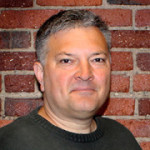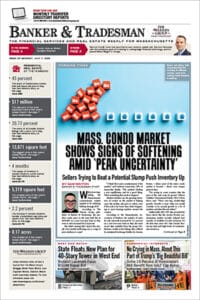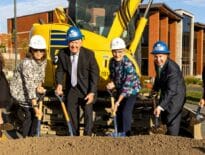
Provisions for arts and cultural spaces in new developments are rare and arts groups continue to face displacement. One exception is BioMed Realty's proposing a 300-seat theater as part of its 585 Third St. office-lab tower in Cambridge’s Kendall Square. Image courtesy of CBT Architects
Arts organizations looking for studio, rehearsal and performance space in Boston quickly discover their options tend to fall into two categories: unavailable and unaffordable.
Rising rents and disruption to business models by COVID-19 over the past 18 months have placed additional pressure on arts groups hoping to maintain an urban presence.
“If we value the arts, we need to have a system to ensure arts stabilization,” said Lars Hasselblad Torres, executive director of the Artisan’s Asylum, a Somerville arts studio and makerspace that’s migrating to a trio of new homes in Allston. “The language we’re using is art stabilization, partnering with long-term stable institutions that can weather the ups and downs in the market and the skyrocketing trajectory of real estate right now.”
Boston Mayor-elect Michelle Wu has some ideas about how to save the city’s cultural venues from extinction. Her arts-and-culture platform calls for the city’s zoning code to be updated with new requirements for studio, rehearsal, performance and live-work artist housing.
The city currently doesn’t have any formal requirements for art space in new developments, although it’s one of the options for activating ground floors, along with retail shops and community venues.
“It’s always easier said than done,” said Morgan Pierson, director of development for Berkeley Investments. “The city would prefer the entire ground floor to be retail or some kind of active component. It’s a great theory but when it comes to reality, that space can sit vacant for years because retailers have other ideas.”
‘A Perfect Storm of Opportunity’
Artisan’s Asylum has provided studios and makerspaces in Somerville for a wide range of artists since 2010, ranging from glassblowers to silk screeners and video producers. But it was unable to secure a long-term extension on its 42,000-square-foot home at 10 Tyler St. Searching in Somerville’s industrial districts such as Boynton Yards and Brickbottom, where life science development is taking off, the group faced prohibitive rents and was routinely outbid trying to acquire properties, Torres said.
As part of that search, Artisan’s Asylum had toured a Berkeley Investments property in Malden, and the two organizations kept in touch. When Berkeley began drawing up plans for an 800,000 development at 176 Lincoln St. in Allston, Artisan’s Asylum seemed like a good fit for a portion of the ground-floor spaces. Approximately 10,000 square feet will be offered to Artisan’s Asylum at below-market rents, Berkeley’s Pierson said.
“That area had a very interesting industrial vibe as well as a history of arts and artists in the Brighton neighborhood. It became a perfect storm of opportunity,” he said.
Harvard University, which owns 176 Lincoln St. and will ground-lease the property to Berkeley Investments, offered Artisan’s Asylum approximately 48,000 square feet at a pair of nearby warehouses. The 55 Antwerp St. location is expected to open soon following electrical service upgrades, and virtually all 70 studios are already reserved, Torres said. Renovations are scheduled to begin at the second property, located at 96 Houlton St.
“[Harvard was] able to put together a package that would be sustainable for us, so we jumped on it,” Torres said. “In our conversations, they have repeatedly stated the goal that we share of ensuring there are strong arts resources in the local community.”
Competition for Partnering on Scarce Spaces
A handful of other private developers are reserving ground floor spaces for arts groups, including some required by local permitting.
In Cambridge, BioMed Realty selected Cambridge nonprofit Global Arts Live to coordinate programming of a ground-floor performance hall at its proposed 585 Third St. project. The property was zoned for a performing arts center under previous ownership, and BioMed agreed to include the 300-seat theater as part of the 550,000-square-foot office-lab tower. The venue will present more than 100 nights of programming annually, BioMed announced in March, and
another 200-plus nights made available to other groups and artists.
Newton-based WS Development has yet to announce a partner for the Seaport Performing Arts Center in an Amazon office tower under construction at 1 Boston Wharf Road, which will include 500- and 100-seat performance spaces opening in 2024. WS also plans to build a second 150-seat venue within a future building in the 7.7 million-square-foot master-planned development.
“They’ve spoken to a lot of groups and not picked a winner, but it’s not just picking the winner,” said James Grace, executive director of the Arts and Business Council of Greater Boston. “Can they develop an operating model to survive and thrive? The space is just the beginning of the conversation, not the end.”

Steve Adams
And in the Fenway, developer Scape agreed to include a 10,000-square-foot LGBTQ-centric performing arts venue in its under-construction housing tower at 1252-1270 Boylston St., which displaced a row of retailers and one of the city’s last gay nightclubs. Scape’s designated nonprofit operator, The Theater Offensive, is in the midst of a capital campaign for the project, director of institutional advancement Cheyenne Myrie said.
Competition to be designated a partner in private projects including art space is fierce and connections between developers and arts groups are haphazard, Grace said. Opportunities to acquire affordable space are rare and usually stem from word-of-mouth connections.
Wu’s arts platform addresses that issue: it would offer city resources to create a calendar and scheduling platform matching artists with public, private and nonprofit groups that own performance and rehearsal space.
“There isn’t a group that is active and a matchmaker,” Grace said. “Each developer really does it as themselves, for themselves, and that’s not a super-efficient way. If there were a partner for them and the artist community, that could be very helpful. I think they both get frustrated.”





